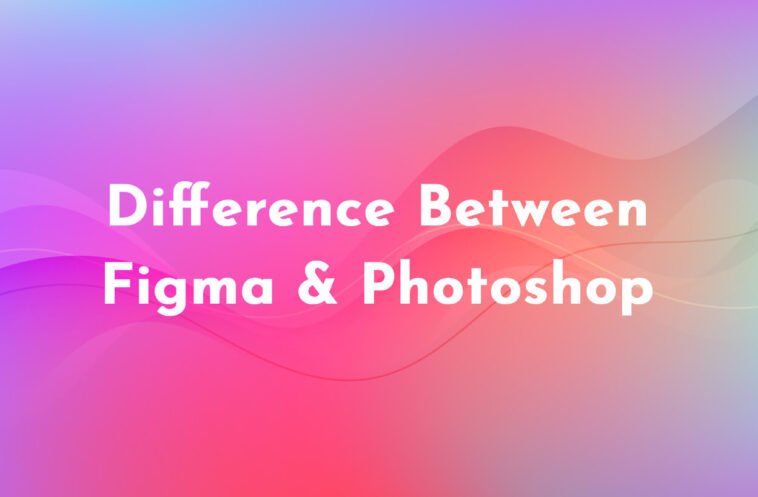Figma and Adobe Photoshop are both popular tools used in the field of design, but they serve different purposes and have distinct features. Here’s a breakdown of the key differences between the two:
01. Purpose and Focus:
- Figma: Figma is primarily a collaborative interface design tool. It’s browser-based and emphasizes real-time collaboration, allowing multiple designers to work on the same design simultaneously. It’s particularly suited for designing user interfaces, wireframes, and prototypes.
- Adobe Photoshop: Photoshop is a raster graphics editor used for image manipulation and digital art creation. While it’s commonly used for photo editing, it’s also used for creating digital illustrations, graphics, and various types of visual content.
02. Platform and Accessibility:
- Figma: Figma is a web-based tool, which means you can access and work on your designs from any device with a browser and an internet connection. This makes collaboration seamless and reduces the need for software installations and updates.
- Adobe Photoshop: Photoshop is a desktop application, meaning it needs to be installed on your computer. However, Adobe has also introduced cloud-based versions of Photoshop that offer some level of online accessibility and collaboration.
03. Collaboration:
- Figma: Collaboration is a central feature of Figma. Multiple users can work on the same design in real-time, making it easier for teams to collaborate on design projects without the need for constant file sharing.
- Adobe Photoshop: Collaboration in Photoshop traditionally involves sharing files back and forth, which can sometimes lead to version control issues. While Adobe has introduced features like cloud document storage, they might not be as seamless as Figma’s collaboration capabilities.
04. Design Workflow:
- Figma: Figma is well-suited for designing interfaces, user experience flows, and interactive prototypes. It has features that allow designers to create interactive components, animations, and transitions, which are essential for modern app and web design.
Figma:
- Collaboration and Real-time Editing: Figma is known for its robust collaboration features. Multiple users can work on the same design file simultaneously, making it great for team projects and remote collaboration.
- Web-Based: Figma operates entirely within a web browser, which means there’s no need to install software. This allows for easy access and collaboration from any device.
- Platform Agnostic: Figma works on both macOS and Windows systems, making it a versatile choice for designers using different operating systems.
- Responsive Design: Figma is designed with responsive design in mind, allowing you to easily create designs for various screen sizes and devices.
- Components and Libraries: Figma offers a system for creating reusable components and design libraries, streamlining the design process and ensuring consistency across projects.
- Prototyping: Figma includes prototyping capabilities, allowing you to create interactive and animated prototypes to demonstrate user interactions.
- Vector Design: Figma primarily focuses on vector-based design, which is ideal for creating scalable graphics and icons.
- Design Handoff: Figma facilitates design handoff to developers by allowing them to inspect design elements and access design specifications directly from the tool.
Adobe Photoshop:
- Raster Editing: Photoshop is a raster graphics editor, which means it’s primarily used for manipulating and editing pixel-based images. It’s the go-to tool for photo editing, retouching, and manipulation.
- Extensive Image Editing: Photoshop is equipped with a wide range of tools for photo editing, including advanced retouching, color correction, filters, and more.
- Print Design: While Photoshop is used for digital design, it’s also commonly used for print design, such as creating posters, flyers, and other print materials.
- Notable for Graphics Editing: Photoshop is the industry standard for graphic designers who work with images and illustrations, especially those who create complex and detailed compositions.
- Lacks Real-time Collaboration: Photoshop is not designed for real-time collaborative work. Multiple designers cannot work on the same file simultaneously like in Figma.
- Less Focused on Responsive Design: While Photoshop can be used for web and app design, it’s less focused on responsive design compared to tools like Figma.
In summary, Figma is more geared towards collaborative design, web design, and UI/UX work, with a strong emphasis on real-time collaboration and responsiveness. Adobe Photoshop, on the other hand, is a powerful raster graphics editor primarily used for photo manipulation and more detailed graphic design work, often for both digital and print mediums. The choice between the two depends on the specific needs of your projects and your design workflow.




